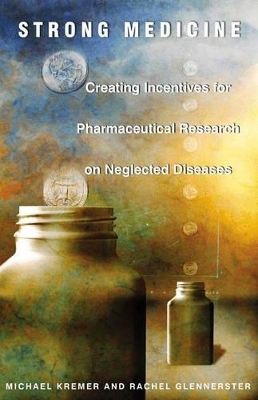
Strong Medicine
Princeton University Press (Verlag)
978-0-691-12113-0 (ISBN)
Millions of people in the third world die from diseases that are rare in the first world--diseases like malaria, tuberculosis, and schistosomiasis. AIDS, which is now usually treated in rich countries, still ravages the world's poor. Vaccines offer the best hope for controlling these diseases and could dramatically improve health in poor countries. But developers have little incentive to undertake the costly and risky research needed to develop vaccines. This is partly because the potential consumers are poor, but also because governments drive down prices. In Strong Medicine, Michael Kremer and Rachel Glennerster offer an innovative yet simple solution to this worldwide problem: "Pull" programs to stimulate research. Here's how such programs would work. Funding agencies would commit to purchase viable vaccines if and when they were developed. This would create the incentives for vaccine developers to produce usable products for these neglected diseases. Private firms, rather than funding agencies, would pick which research strategies to pursue. After purchasing the vaccine, funders could distribute it at little or no cost to the afflicted countries.
Strong Medicine details just how these legally binding commitments would work. Ultimately, if no vaccines were developed, such a commitment would cost nothing. But if vaccines were developed, the program would save millions of lives and would be among the world's most cost-effective health interventions.
Michael Kremer is Gates Professor of Developing Societies at Harvard University, Senior Fellow at the Brookings Institution, and NonResident Fellow at the Center for Global Development. He founded and was the first executive director of WorldTeach, a nonprofit organization that places two hundred volunteer teachers annually in developing countries (1986-1989). He previously served as a teacher in Kenya. Rachel Glennerster is Director of the Poverty Action Lab at the Massachusetts Institute of Technology, a center devoted to evaluating the effectiveness of anti-poverty programs. She has worked on health and development policy at the UK Treasury, the Harvard Institute of International Development, and the International Monetary Fund.
Foreword ix Acknowledgments xiii 1.INTRODUCTION 1 2.HEALTH IN LOW-INCOME COUNTRIES 6 The Disease Environment in Low-Income Countries 6 Weak Health-Care Infrastructure 7 Malaria, Tuberculosis, and HIV/AIDS 11 The Impact of Cheap, Simple Technologies 20 3.THE PAUCITY OF PRIVATE R&D TARGETED TO THE NEEDS OF LOW-INCOME COUNTRIES 25 The Extent of R&D Targeted to Low-Income Countries 25 The Scientific Potential for New Vaccines 27 4.MARKET AND GOVERNMENT FAILURES 29 Why Target Foreign Assistance to Vaccine R&D? 30 The Patent Tradeoff 33 Low-Income Countries and Intellectual Property 36 Social versus Private Return: Some Quantitative Estimates 40 The Role of Public Purchases 42 5.THE ROLE OF PUSH PROGRAMS 45 Meningococcal Meningitis: An Example of a Successful Push Program 46 A Cautionary Tale: The USAID Malaria Vaccine Program 47 Incentives under Push Programs 49 6.THE POTENTIAL ROLE OF PULL PROGRAMS 55 The Effect of Market Size on Innovation 55 The Impact of Financial Incentive Programs 56 Examples of Pull Programs Stimulating Research 59 Advantages and Limitations of Pull Programs 63 7.PULL PROGRAMS: A MENU 68 Commitments to Finance Purchase of Products and Patents 68 Patent Extensions on Other Pharmaceuticals as Compensation for Vaccine Development 70 Best-Entry Tournaments 72 Expanding the Market for Existing Vaccines and Drugs 73 8.DETERMINING ELIGIBILITY 76 Basic Technical Requirements 76 Independent Adjudication Committee 78 Market-Test Requirement 81 Exit Clauses 84 9.HOW MUCH SHOULD WE PROMISE TO PAY FOR A VACCINE? 86 What Market Size Is Needed to Spur Research? 86 Cost-Effectiveness: What Is a Vaccine Worth? 90 10.HOW SHOULD PAYMENT BE STRUCTURED? 97 Paying for Multiple Vaccines and Market Exclusivity 100 Bonus Payments Based on Product Quality 103 Increasing the Promised Price over Time 105 Avoiding Windfalls 106 Industry Consultations 107 11.SCOPE OF THE COMMITMENT 109 What Diseases to Cover? 109 Vaccines, Drugs, and Other Technologies 109 Incentives for Agricultural R&D 112 12.MOVING FORWARD WITH VACCINE COMMITMENTS 115 Making a Commitment Legally Binding 116 The Politics of Creating Markets for Vaccines and Drugs 118 Potential Sponsors of New Markets for Vaccines and Drugs 119 References 127 Index 145
| Erscheint lt. Verlag | 27.9.2004 |
|---|---|
| Zusatzinfo | 6 line illus. 3 tables. |
| Verlagsort | New Jersey |
| Sprache | englisch |
| Maße | 152 x 235 mm |
| Gewicht | 397 g |
| Themenwelt | Medizin / Pharmazie ► Gesundheitswesen |
| Medizin / Pharmazie ► Medizinische Fachgebiete ► Pharmakologie / Pharmakotherapie | |
| Medizin / Pharmazie ► Pharmazie | |
| Studium ► Querschnittsbereiche ► Prävention / Gesundheitsförderung | |
| Technik | |
| Wirtschaft | |
| ISBN-10 | 0-691-12113-3 / 0691121133 |
| ISBN-13 | 978-0-691-12113-0 / 9780691121130 |
| Zustand | Neuware |
| Informationen gemäß Produktsicherheitsverordnung (GPSR) | |
| Haben Sie eine Frage zum Produkt? |
aus dem Bereich


